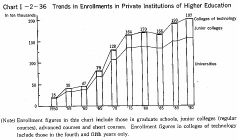| Home > Policy > White Paper, Notice, Announcement > White Paper > JAPAMESE GOVERNMENT POLICIES IN EDUCATION,SCIENCE AND CULTURE 1990 > PART |
||
Since the end of World War ![]() private institutions have played
an important role in the dissemination of formal education in Japan. The role
of private institutions has been great, especially at the higher education level.
As of 1 May 1990 there were 874 private universities, junior colleges and colleges
of technology enrolling 1,970,000 students, which accounted for 75% of all universities,
junior colleges and colleges of technology in the number of institutions and
76% in enrollment. Retrospectively, in 1950 there were 278 private institutions
of higher Education, in which 180,000 students were enrolled. The economic growth
of the nation which began in the second half of the 1960's brought about a rapid
increase in university applicants, which led to the expansion of private institutions:
many new institutions, faculties and departments were created and the number
of student places was increased. As a result, both the number of private institutions
and the enrollment therein have dramatically increased, and today private institutions
constitute a great part of the higher education system in Japan, quantitatively.
(See Chart
private institutions have played
an important role in the dissemination of formal education in Japan. The role
of private institutions has been great, especially at the higher education level.
As of 1 May 1990 there were 874 private universities, junior colleges and colleges
of technology enrolling 1,970,000 students, which accounted for 75% of all universities,
junior colleges and colleges of technology in the number of institutions and
76% in enrollment. Retrospectively, in 1950 there were 278 private institutions
of higher Education, in which 180,000 students were enrolled. The economic growth
of the nation which began in the second half of the 1960's brought about a rapid
increase in university applicants, which led to the expansion of private institutions:
many new institutions, faculties and departments were created and the number
of student places was increased. As a result, both the number of private institutions
and the enrollment therein have dramatically increased, and today private institutions
constitute a great part of the higher education system in Japan, quantitatively.
(See Chart ![]() -2-36.)
-2-36.)

In recent years, as our society has become more "internationalized." More information-oriented and more mature, educational institutions as a whole are required to carry out more distinctive and more unique educational programs in response to the more diverse and more heightened demands of people. In this context, in addition to their quantitative contribution to the dissemination of formal education, private institutions are playing a more and more important qualitative role in developing unique and diverse educational and research programs on the basis of their founders' philosophies and principles.
There were two special features in the post-war government policies towards private institutions. Firstly, under the Fundamental Law of Education. School Education Law and Private School Law, the powers of government authorities regarding private institutions were drastically reduced, and high regard was paid to the autonomy of these institutions. Secondly, the right to found private institutions was given primarily to non-profit "school corporations." In order to make clearer the public role of private educational institutions set up by school corporations, the government specified that, with regard to its structure and management, every school corporation should have such an appropriate mechanism as is relevant to the organ managing educational institutions. This provision was intended to make up for insufficient general provisions regarding non-profit corporations in the Civil Law.
The Private School Law enacted in 1949 clarified the legal possibility of government aid to private institutions by specifying that the national and local governments may provide necessary financial assistance for the educational pro-grams of private institutions. In addition, the Law allowed school corporations to undertake profit-raising programs to contribute to reinforcing the financial basis of the institution maintained by each corporation. Both provisions were of great significance in helping stabilize the financial conditions of private educational institutions.
Regarding government financial assistance, a Private School Promotion Subsidy Law was enacted in 1975. The law provided for government subsidies to private universities and other institutions for their current expenditures, and also specified that both the national and local governments should strive to give school corporations favorable consideration regarding taxation. Under this law, the national government has been making efforts to promote the activities of private institutions, through (1) providing subsidies to private institutions for their current and other expenditures, (2) offering long-term loans to private institutions through the Japan Private School Promotion Foundation, and (3) taking favorable taxation measures to school corporations.
It is necessary for private institutions to strive to strengthen their own financial basis by their self-supporting efforts, to attempt to make students' financial burdens for learning more reasonable, to strive for the maintenance and improvement of the physical and human conditions of their educational and research programs, and thus to develop themselves into unique and attractive institutions.
| Back to Top | MEXT HOME |